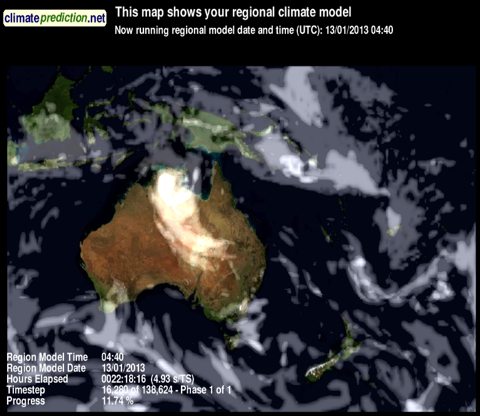
That’s a climate model running on my iMac, thanks to BOINC, Climateprediction.net, and the new New Zealand and Australia modelling experiment launched yesterday. In this guest post, Dr Suzanne Rosier of NIWA explains what it’s all about…
A new citizen science experiment in which scientists will address possible links between climate change and extreme weather in Australia and New Zealand was launched on Wednesday. Weather@home ANZ runs as part of the highly successful climateprediction.net project based at the University of Oxford, which makes state-of-the-art climate models available for anyone with a PC and an Internet connection to download and run on their computer. The global model contains within it a much more detailed model of the Australia/New Zealand region, detailed enough to model weather events properly, and the ‘2-in-1’ model needs to be run many thousands of times if scientists are to have a chance of capturing the very rarest weather events. This takes a huge amount of computing power – and you can help by volunteering your computer.
The model runs in the background on your machine, taking up any processing power that happens to be spare, but not interfering with your work. When your computer has finished crunching the results are automatically uploaded to a server at the University of Tasmania. If you take part in the project you also have the option to see how the model you are running on your machine is progressing. Many thousands of generous volunteers have already taken part in climateprediction.net, running global models, and Weather@home, running regional models for other parts of the world. This is your chance to get involved and help scientists to gain a better understanding of what is happening to weather in Australia and New Zealand region as the climate changes.
The experiment launched today will produce many thousands of different simulations of how the weather in 2013 might have been, both with and without anthropogenic greenhouse gas emissions. This will enable scientists to put some hard numbers on how the risks of extreme weather events might — or might not — be changing as a result of the human contribution to global climate change. Scientists at NIWA will focus initially on the severe North Island drought of January to March 2013, but later the record-breaking warmth of last year’s winter will also come under scrutiny. Extreme rainfall events, such as that in Golden Bay and Nelson in December 2011 and the recent floods in Christchurch, will also be investigated as the Weather@home ANZ experiment continues.
The more people who participate, the more science can be done. Please go to ‘weatherathome.net’ – sign up, and start crunching numbers.
Gareth adds: Suzanne does an excellent job of introducing the project in this video:
[vimeo 89989061 w=480]
Read more about the project at Climateprediction.net, The Conversation, and NIWA. If anyone’s interested in running an NZ climate team, let me know. For some background to the difficult statistics of extreme weather events, I highly recommend this recent article by Stefan Rahmstorf at RealClimate. The Weather@home ANZ models will run (via BOINC, the framework for distributed processing developed at Berkeley and used in a wide variety of distributed computing projects such as Seti@home or Folding@home) on most recent releases of Windows, Mac OSX and Linux.

It just occurred to me that while this MBP flaps about all over the place and is clammed much of the time, the somewhat older iMac Snow Leopard print server cum AppleWorks archiver is available 24/7. It should work just fine for crunching numbers.
I’ve got one of those too! 🙂 I’ll sign it up. Trying to keep the new lappy unclogged.
iMac is chugging along happily. A bit sluggish at times, but hey! that was pretty normal. Activity Monitor shows that BOINC gets out of the way promptly if CPU cycles are needed by other apps….sheesh! OSX has a load of cobblers running at any given time….I wonder what they all do?
Clearly the project requires some heavy lifting: each module will take over 9 days to process. Still, every widder’s mite helps.
It would be interesting to see how the wind is altering its pattern too. Winds do seem to be increasing in intensity over the past few years and the increased speed of the trade winds over the past decade is one of the major explanations for the so called “pause”. Over looking the Firth and the Hauraki Plains as we do here, the wind is a major factor in our weather, or should I say it’s very noticeable – but then nothing of value comes without a “cost” :). Our sunsets over the water have to be experienced.
The last two days I have been enjoying a bit of wind after a month of light and variables excluding lusi. Now the light and variables are back. I have been wondering if just as we had September weather in August last we are now having the weather I used to associate with the last two weeks of January and the first two weeks of February in March this year – It is Auckland of course.
I would do it but I shut my computer down when I finish work.
Apparently computers left on in offices has a bigger carbon footprint than the airline industry, I heard once.
I suspect it’s apocryphal or may not apply to modern computers that almost shut down completely when asleep, but whatever, a computer that working for a good cause has a valid excuse to continue sipping power. Esp in NZ where our power is predominantly hydro with minimal footprint.
Certainly more valid than the 2-tonnes of metal we deem necessary to commute to work in each day.